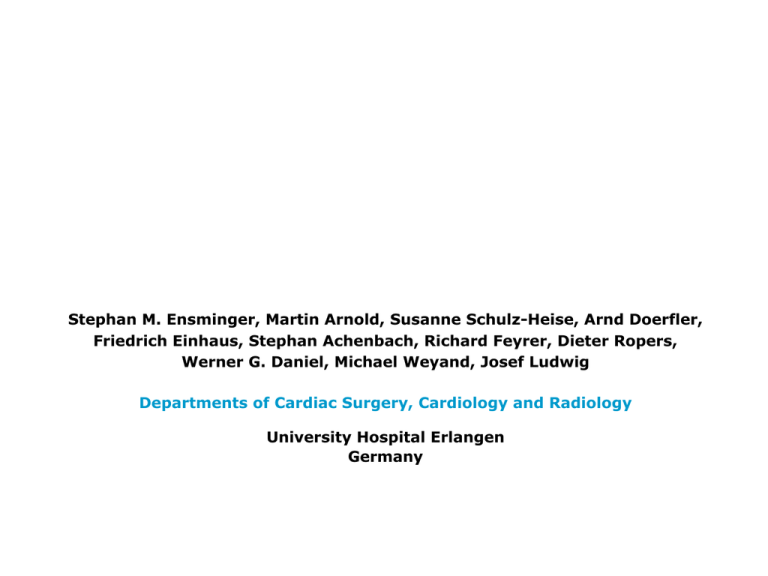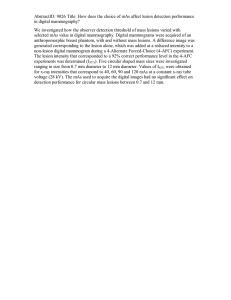Embolic Cerebral Insults After Percutaneous Aortic Valve
advertisement

Embolic Cerebral Insults After Percutaneous Aortic Valve Replacement Detected by Magnetic Resonance Imaging Stephan M. Ensminger, Martin Arnold, Susanne Schulz-Heise, Arnd Doerfler, Friedrich Einhaus, Stephan Achenbach, Richard Feyrer, Dieter Ropers, Werner G. Daniel, Michael Weyand, Josef Ludwig Departments of Cardiac Surgery, Cardiology and Radiology University Hospital Erlangen Germany I will not discuss off label use and/or investigational use. The following relevant financial relationships exist related to my or any other author´s role in this session: No relationships to disclose Stroke Risk: Passage of calcified aortic valve 3 Stroke Risk: Valvuloplasty 4 Stroke Risk: Positioning and implantation of prosthesis 5 Stroke Risk: Hypotension during “rapid pacing“ 6 Clinical rate of stroke following TAVI 7 Bauernschmitt et .al 2009 n=149 7% Al-Attar et al. 2009 n=50 4/50 (8%) Thielmann et al. 2009 n=39 1/39 (3%) Ye et al. 2009 n= 26 1/26 (4%) Walther, et al. 2008 n= 50 0% Grube, et al. 2007 n= 86 10% Imaging of cerebral lesions by MRI before and within 7 days after transapical TAVI in 25 patients Diffusion Weigthed Imaging (DWI) (Most sensitive method for early visualization of ischemia driven diffusion abnormalities) FLAIR sequences (to quantify lesion size) T2 weightes sequenzes (to quantify lesion size) T2 weighted gradient echo FLASH sequences (to differentiate bleeding and ischemia) 8 25 patients 9 Gender (f/m) 15 / 10 Age (years) 81 ± 5 Log. EUROSCORE (%) 32,3 ± 10 LV-EF (%) 51 ± 14 AVA (cm2) 0,8 ± 0,2 Atrial fibrillation (pre-operative) (n) 15 Earlier stroke (n) 6 Carotid stenosis > 50% (n) 9 Creatinine (mg/dl) 1,25 ± 0,6 pro NT-pro BNP (U/l) 6354 ± 9571 NYHA III (I; IV) Procedure duration (min) 111 ± 30 Fluoroscopy time (min) 10 ± 5 Postoperative ventilation > 24 hours (n) 2 Valve Size 23 mm (n) 26 mm (n) 7 18 Evidence of Post Procedure Ischemic Lesions 68% 9 8 Number of new lesions: 7 6 5 4 3 2 8 4 1 7 6 0 1 2 3 1: 2: 3: 4: No new lesion 1 new lesion 2 -5 new lesions > 5 new lesions 4 12 Size of lesions: 10 8 6 4 4 11 2 2 0 1 2 1: < 5 mm 2: < 10 mm 3: > 10 mm 3 All lesions of typical morphology for embolism 10 Example 1 Symptomatic stroke. > 5 lesions up to 41 mm 11 Example 2 > 5 lesions up to 12 mm. Clinically asymptomatic. 12 Affected Vascular Territories 4 27% 1 38% 3 2% 2 33% 1 = Arteria cerebri media, 2 = Arteria cerebri posterior artery, 3 = Arteria cerebri anterior, 4 = Cerebellum/ Hirnstamm. 13 Clinical Events: Patient Clinical MRI 79 J, w, 26 mm Sapien, 120min OP, Fl 9.8 min, Afib, pVD. Severe stroke, reduced vigilance > 5 lesions, max. 41 mm 78 J, m, 26 mm Sapien, 65 min OP, Fl 5.5 min., Afib, pVD TIA (vision) Singular brain stem lesion 72 J, m, 26 mm Sapien, 170 min OP, stroke, PHT. Transitory psychotic syndrome > 5 Lesions, 76 J, m, 26 mm Sapien, 95 min OP, Fl 15.7 min, EF 20%, CAD, pVD, A fib, right carotid occlusion. Transitory psychotic syndrome > 5 Lesions, 84 J, Transitory psychotic syndrome No lesion w, 23 mm Sapien, 65 min OP, Fl 5.7 min, EF 35%, carotic stenosis (~50%) bilaterally. 14 3rd postoperative day > 7mm. > 7mm. Results Summary New embolic cerebral lesions seen in more than 2/3 of patients (68%) after transapical TAVI Clinical symptoms are infrequent (15%) Size and number of lesions not tied to symptoms. 15 Other Publications: Transfemoral N = 31 0% (0) stroke 87% (16) lesions Circulation 2010 Transfemoral N = 22 4% (1) stroke 73% (16) lesions JACC 2010 16 Conclusion New embolic ischemic cerebral insults are detected in 68% of patients after transapical valve replacement. Clinical symptoms are rare and usually transitory. Larger trials will need to establish the clinical significance of asymptomatic ischemic lesions as well as the rate of ischemic events in transfemoral/transapical/surgical aortic valve replacement. 17



